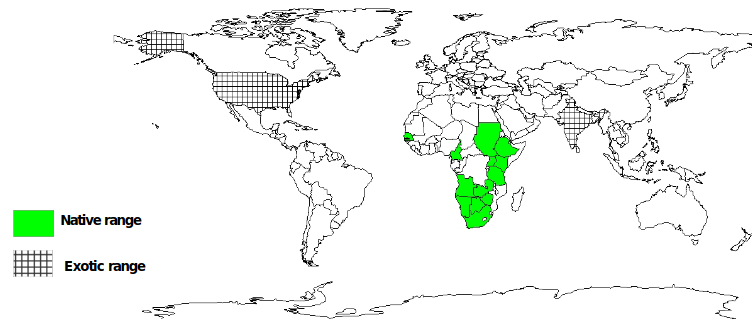Publication
from Agroforestree Database:a tree reference and selection guide version 4.0
by Orwa C, A Mutua, Kindt R, Jamnadass R, S Anthony
Garcinia livingstonei T. Anders
Local Names: English (wild plum, wild mangosteen, lowveld mangosteen); Swahili (mutumbi, mpekechu)
Family: Guttiferae
Botanic Description
Garcinia livingstonei is
a shrub or small evergreen tree to 10 m; crown dense, spreading or
conical; trunk short, often twisted, occasionally multistemmed. Bark
reddish brown to dark grey, with shallow grooves or deeply fissured,
ridged and scaly, exuding yellow or red resinous latex when cut.
Leaves
simple, in whorls of 3, stiff and leathery or brittle, variable in
shape, sometimes with a slightly wavy edge; dark green and glossy
above, dull and pale green below.
Flowers white or pale to
yellowish green, 6-14 mm diameter, borne in small groups in axils of
older branches. Male and female flowers normally separate, but with
some bisexual flowers.
Fruits ovoid to round berries, 2.5-3.5 cm
long and 2.5-3 cm broad; orangeyellow, reddish, or purple; 1-2 seeded.
Seeds creamy brown.
The generic name is after L. Garcin (1683-1751), a naturalist and a correspondent of Linnaeus.
Biology
Flowers in September at the Kenya coast and fruits in February-March. Elsewhere it flowers in June and fruit ripens in August.
Ecology
In
South Africa, it is found in scrub, open woodland and forest; in
Zimbabwe, usually along rivers in the low veld and frequently in
riparian and munga, mopane woodland and termite mounds in Zambia. Also
found on rocky soil away from water and in open coastal forest.
Biophysical Limits
Altitude: 0-1 900 m
Mean annual temperature:
Mean annual rainfall: 800-1800 mm
Soil type: It is hardy and successful on acid sandy and alkaline rocky soils.
Documented Species distribution
Native: Angola, Botswana, Cameroon, Ethiopia, Kenya, Namibia, Senegal, South Africa, Sudan, Tanzania, Uganda, Zambia, Zimbabwe
Exotic: India, United States of America

The map above shows countries where the species has been planted. It
does neither suggest that the species can be planted in every
ecological zone within that country, nor that the species can not be
planted in other countries than those depicted. Since some tree species
are invasive, you need to follow biosafety procedures that apply to
your planting site.
Products
Food:
The juicy fruit pulp is acid-sweet, pleasant tasting and refreshing.
Fruits are eaten raw or cooked with porridge.They are rich in
carbohydrates (mainly sugars) and have moderate mineral content.
Fodder: Leaves and young shoots are browsed by animals.
Fuel: The tree is used as fuelwood.
Timber: The wood is used as small timber, implements, fencing posts and rails.
Alcohol: An alcoholic drink is made from the fruit in East Africa.
Poison: The yellow oily sap is used to manufacture arrow poison and decorate arrows.
Medicine:
Extracts from flowers and leaves have antibiotic properties. Infusion
made from roots used to treat abdominal pains during pregnancy and
after giving birth. Fruit used to treat mumps.
Other products: G. livingstonei
is the source of Guttiferone A. The Guttiferones are polyisoprenylated
benzophenone derivatives that inhibit the cytopathic effects of in
vitro HIV infection.
Services
Erosion control: The tree has a bulbous base underground which holds the soil.
Shade or shelter: It is used as a shade tree.
Ornamental: The stiff, unsymmetrical growth and the grey-green stiff foliage give the tree an unusual and striking appearance.
Further Reading
FAO.
1988. Traditional food plants: a resource book for promoting the
exploitation and consumption of food plants in arid, semi-arid and
sub-humid lands of East Africa. FAO food and nutrition paper 42. FAO,
Rome.
Maundu PM et al. 1999. Traditional food plants of Kenya. National Museums of Kenya.
|
|